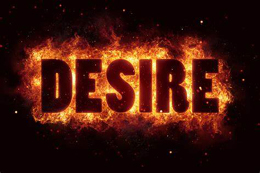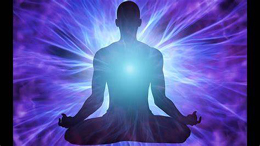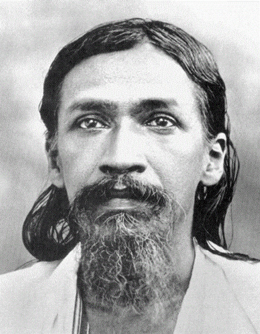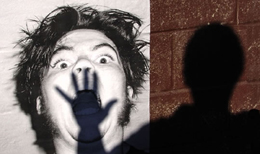Growth
Going Beyond Desire and Aversion
Abstract
Sooner rather than later, desire and aversion must be addressed if one is on any path of growth. In Integral Yoga, they cannot be tackled in isolation, but only within context of the whole. Desire and aversion are two parts of the same thing. This article is written especially for those in the process of developing their practice in Integral Yoga. It explores ways of short-circuiting the onset of desire in the first place. It looks at ways of transforming its vibration the divine counterpart, which is aspiration.
We struggle with desire because we fail to find a true place for it. The force demands our understanding. We have to fully understand its nature and know where it comes from if we are to direct it to its proper home. It is a universal force, first of all, so wrestling with it is not going to get us very far. It is everywhere! It is a cosmic force, a favourite weapon of the adverse forces. If we choose to wrestle with it, then what do we have at our disposal? The very choice indicates a lack. The soul doesn’t wrestle, only the vital ego, which lies at the heart of the problem in any case. It is a problem because it is a state that ultimately causes intense suffering.
I cannot claim to have conquered it myself and I don’t believe I’m unique on this. I have made wrong turnings in my life. I still find myself painfully burrowing my way (sometimes painfully) through a dark tunnel towards the Light. We are all work in progress. We even hear of self-proclaimed gurus being exposed while dipping their toes into the mire. For much of society however, it is barely a struggle at all: most just succumb and give their consent. No questions are asked. It is a fact of life and most just ‘live with it’. This force is buried under countless layers of human insincerity. Not surprisingly then, desire is a major wheel in the world system and economy.
A conventional response sometimes intervenes, urging moderation. This will be self-imposed and a fragile compromise might be reached. A limit and a check are constructed, with the intention not to ‘transgress’ any further. Such is the notion of sin in everyday life. It is a response of the rational mind.
On entering yoga, it becomes imperative to find a more permanent solution to the malaise, but one has to evolve quite far in one’s practice to dispense with the leverage of the ordinary mind. The traditional yogic practices do not address the roots of desire. When one is attempting to rise above them into a state of complete transcendence one has to climb a mountain-top of spirituality, which leaves the woes of the ordinary life far below. Many are inspired to join the Masters in their ascent but the roots of ordinary human suffering and dissatisfaction are left unobserved and untouched. It is only by knowing the root that an affliction can be transformed.
Sri Aurobindo’s Yoga addresses the integrality of the human being, every facet of the nature, not just the roots of desire. We have to work on ourselves. There are no shortcuts or quick fixes for desire: the whole of our being has to be addressed. Every part of our self is interrelated. Integral Yoga aims at transforming the source of every human ignorance and suffering. The whole nature must be divinised in its comprehensive sweep. Everything has to be illuminated; nothing can be taken out of context and no detail can be ignored. Nothing can be achieved until everything is done. A perfect and true integer is the aim of its practice.
The duality of desire
The truth is, desire is part of a duality. At the flipside of desire stands aversion. In truth, just as with pain and pleasure, which Sri Aurobindo identifies as “the same thing (1)”, desire and aversion have the same source. They come from the same universal force, though they find expression in different conditions and guises. Desire is the foundation and the trigger; aversion is the consequence. The two operate in a cyclical fashion. Desire sets aversion in motion. In cases of sexual violence though, the two states seem to be horribly mangled together. More typically though, they operate in sequence. As soon as we accommodate a desire and attempt to satisfy it, one spits it out in aversion. As soon as a desire is satiated, one feels pain and anguish.
This pain can also manifest on a gross physical level: it is not just a psychological phenomenon, our whole being is affected. It comes from a sense of overload and the knee-jerk way of dealing with the pain is through the sense of repulsion.
Once a desire is ‘satiated’, one will hold onto this state of aversion for a certain period of time. The intensity and length of this experience depends on the individual nature and also the level and mode of the desire. The interval may even bring a semblance of relief. However, unhealthy morbid patterns and habitual tendencies will also come up with the recoil of aversion. One may experience a huge weight of guilt and self-blame for having succumbed to the desire in the first place. We shrink and any feeling of self-worth may get shot to pieces. One may slump into depression. Just as desire inflates, the resulting aversion brings with it psychological emaciation. It twists the lower vital into uncomfortable contortions; it might even turn this side of our nature in upon itself in an atmosphere of self-harm.
Our journey
This article is not really written for the curious. It is addressed to those sincere about transforming their entire way of living. It is not only about desire and aversion because it is my understanding that Integral Yoga can offer a panacea for all human woes. So, why stop at one single affliction? They are all interconnected. The yogic practice is valid for the full range of human afflictions. But we need to engage vast resources of aspiration and apply effort to overcome them.
Put simply, desire is just a consequence of not living one’s Truth. It is a sign of wrong living; desire is not in its true place. But very few can claim to be clear of it. Desire’s tentacles spread over virtually every living being on the planet, not just human. It is the chief moving-force behind the animal kingdom. But the mental side to man gives the state its lethal twist and provides an additional cause of human suffering.
We are what we are, in our present status within time and space. We have to acknowledge that we are vessels in transition. We are applying effort to grow and we are consciously practising at changing our nature and our lives. The Divine has summoned us and we are heeding her call. We are evolving souls on the same path, aiming to bring harmony and true fulfilment into our existence. Finally, we have realised that there is no longer any space for desire or any other wrong movement in our lives. But one has to progress very far to become desire-less and free. We have to work at bringing the psychic being forward and establishing the true consciousness, whose dynamic alignment with Force gives it the capacity to transform and change.
“The first condition for getting rid of desire is therefore, to become conscious with the true consciousness; for then it becomes easier to dismiss it than when one has to struggle with it as if it were a constituent part of oneself to be thrown out from the being. It is easier to cast off an accretion than to excise what is felt as a parcel of our substance.
“When the psychic being is in front, then also to get rid of desire becomes easy; for it has only aspiration and a seeking and love for the Divine and all things that are or tend towards the Divine (2).”
It is a long and difficult voyage to the harbour of the psychic realisation. The journey is impossible without surrender. It is our love for the Mother that makes it worthwhile. The psychic being alone can show us the true context for desire and aversion. Every human distortion finds its true place through the psychic influence. The psychic being exists in a different dimension and its realisation is surely the greatest achievement one can make in a lifetime. Such ‘achievements’ produce more than just a ripple effect on the world around. Indeed, they auger and herald the promised terrestrial transformation. The psychic does not work through coercion, but through its innate power of harmony. Its reach is sublime and subtle and it is only there that we will ever find the true solution: the transformation of all desire.
So, given our present condition, what is the best way of tackling this problematic energy? Clearly, we need to look at this state in a true but realistic light. Firstly, I don’t believe desire can be tackled head-on. Neither (as discussed) can it effectively be dealt with in isolation. The whole of our nature has to be placed under the lens of our observation and practice. Our trust in the Mother and the process gives us the capacity to do this. Next, we cannot sit on these kinds of tendencies any longer. We are using an inferior instrument when we try to do this. The ordinary mind can only address superficialities and even that, to a very limited extent.
Looking back, suppression has been the usual means, but truly, it does not even offer a halfway solution. Sometimes this course will arouse even greater mental anguish. Its parsimony creates nothing but greyness inside and we might emerge dry and drained of life. Every effort has its use, but a better way has to be found. The true answer is inside us. Even if we don’t actively indulge and (perhaps even more so!), we might carry this atmosphere around us wherever we go. Bottling a thing often exacerbates the problem. These tiny little vital entities will swarm around us for a lifetime. They become part of our consciousness because our preoccupation is continually there.
Once we identify with desire, we only become it. It’s what we relate to but cannot even begin to understand. The lack of true understanding is the crux of the problem. It has a deadly and deleterious effect on our entire being. Our balance and mental health get disrupted and the very part that is feeding it, the vital, will become worthless and ineffectual through persistent misuse. Desire plagues and fatigues the body. The final result amounts to a travesty of the tenets of Vital Education, so clearly and explicitly described by the Mother1.
Desire can even become the catalyst for our spiritual downfall. So, the question is, how should we address desire, given our present condition? It is imperative we find a way. I n truth, it sometimes seems that we are embarking on a path of pain. Whichever way we turn, there is pain. It might take a while to fully embark on the ‘Sunlit Path’.
In Integral Yoga, we have to confront our shadows. With the effort comes the pain. We will suffer when trying to resolve our desires but it helps to look at this pain as just a process. It can also bring out the hero in us. So firstly, we need to access our Warrior Self. It is in all of us. It is a Self that is full of courage and makes light of any difficulty and pain. The warrior comes to us through aspiration, because aspiration is the fuel for all meaningful progress. Whatever obstacles facing him or her, the Aryan will pierce below the surface in search of the Truth.
Pain is always giving us a message. Once we live in alignment with the Truth, pain will go. The true consciousness won’t allow it. If we don’t liberate ourselves from the shackles of desire, the pain will persist and perhaps even grow over countless lives. We are on a path of transformation and we are here to deal with desires and everything else in this life.
Catching desire before ignition
So, we come to the practice. There is always a spark of resonance which ignites desire. This spark needs to be snuffed out before it becomes a blaze. The force spreads by contagion and is all around us. The energy is manipulated by adverse forces that search for the slightest fissure to invade and activate their imprint. There is some part of our nature that covertly invites it. Once it lodges inside, it can spread to our external behaviour. Once desire is entertained, it is very difficult to annul it. The very effort to clear one’s way through it will engender pain.
It needs to be resolved as soon as we notice it, because the chain-reaction may be instantaneous. It may sometimes subtly simmer and accumulate waiting for the chance to explode at a future date. Anyway, it has been invited and won’t willingly go away. We need to stay awake to all these inner movements. This implies that a considerable amount of sincerity and vigilance is required. We have to try to become conscious of these vibrations if we don’t want to become their slave. At the very least, we must become aware of them. Whatever affliction one deals with, this practice of ‘catching’ a wrong movement as soon as it appears is a key to changing one’s nature.
“To catch each thing that should not be done, catch it like that, and then hold it firmly in front of the light until the light can act upon it to transform it: this is the work one can do all the time. No matter what one is doing, one can always do this work. Each time one becomes aware that there is something which is not all right, one must catch it like this, prevent it from hiding, for it tries to hide: catch it and then keep it like this before the light of one’s conscious will, and then put the light upon it so that it changes (3).”
This takes practice. We apply our attention onto the vibration as soon as we become conscious of it. As soon as we catch it, we place a light upon it. At the same time, we remember to offer. Try to make these three responses simultaneous. There must always be a thread connecting us to the Divine. It is the psychic which births the true aspiration which is essential to this process. We must try to cling onto this entity at all times.
There needs to be something; our consciousness has to stay awake. We must concentrate upon this presence, but even when engaged in daily activities; hold it always within our consciousness. Allow it to radiate and grow. Make it the most important thing in your life. The true consciousness has the capacity to embrace every detail without losing sight of the whole. We need to keep a continuous stream of practice in all circumstances.
The practice of japa
For this, I find japa invaluable: it maintains this continuity of practice. It has a natural way of keeping us aligned inside. It exerts a power that helps us stay within. With aspiration and persistence, the flow of our practice can then be sustained. The sādhanā should be round-the-clock, 24 x 7, and vibrate inside us even when asleep. That is our aim, at least. We sometimes move inch by inch towards this goal but with japa, as long as it is sincerely maintained, we will always move forward without risk of reversal. It fosters a continuity of practice, something inside us that never sleeps.
It is an exercise in purification. The practice of japa can be ingrained into the very depths of our being. With practice, our entire being starts to vibrate in tune with the sacred Word. Once the mantra is established, there will be no seizure or interruption. The continuous thread will always be maintained. We are accessing a way to always operate from inside. Whenever we live in surface-mode, the thread will be lost. Indeed, it only invites more of these adverse vibrations to appear. They will come and go without our attention. Any opportunity to transform them is lost.
So, the moment we catch the vibration, we offer it. Try to synchronise this with the japa. We can offer always, the good and the bad, because everything inside us is just a mixture. We can offer in our meditation and we can offer when immersed in our daily chores. Always remember to offer your desires: offer them when they are germinating inside your being and offer after you lapse and seek satisfaction. It is never too late to offer.
With conscious practice, you will learn to short-circuit the onset of desire. The response becomes more efficient and effective. We can offer it to the Fire of Purification that burns inside our heart. Be conscious of this Fire and make sure your aspiration is always present to tend to it. The Mother has lit it but we must always look after it. The more we practise, the more this Fire will grow. Catch the adverse vibration with your consciousness and toss it onto the Fire. A tangible shift will occur and we move to a realm of dynamic change. Of course, we can offer and leave all our movements directly at the feet of the Mother. This Fire holds identity with Her.
This simultaneous practice works to transform all our movements. Desire is but one of many different vibrations. But the remedy can be the same. Try not to segregate the ‘good’ from the ‘bad’, because even what we regard as our virtues need to be transformed. Every part of our nature can be swept up in the psychic embrace.
That is our path. We are also on a collective yoga. You, the microcosm, by changing your nature can help to influence the entire yoga collective. Address the wholeness of your being and it will leave an imprint on others around. Don’t let the mind select what needs to be addressed: the process can be applied to every one of our movements. Take anger for instance, its onset can be diffused and transformed immediately by this practice. So, as soon as the movement is recognised, follow the same procedure and step back, catching it with our consciousness, put a light on it and offer.
The human being is a creature of habit, so as one consciously observes, one can eventually interpret those cues that are feeding this pattern. Desire is subjected to habit like anything else. Observation is an art and, with sustained practice, we begin to read and follow the signals so that our consciousness can more readily catch these repetitive patterns. Allow the foresight to seamlessly integrate into your sādhanā.
The transformation of desire
We must always seek to refine and purify our consciousness. Armed with sincerity, it will heighten and expand through stages. Each experience is a benchmark. Just allow the Divine to set the pace for you. It all comes from our relationship with the psychic being. The true consciousness identifies exclusively with the psychic being. Because of that, “The Divine Consciousness is not only aware but knows and effects (4).” It transcends the Witness poise and can transform all our movements. The true consciousness is the executor of this Will and transforms desire and aversion into the sublime poise of aspiration. The present state of desire is only a deformation of aspiration and there is no space for it in the New World.
Infuse your desires with your highest consciousness and see if their orientation can change, “.... what you have to do is shift the objective of desire: instead of turning it to something towards things that are external, artificial, superficial and egotistical, you must join it as a force of realisation to the aspiration to the truth (5).”
References
1. Sri Aurobindo. Birth Centenary Library, Volume 18. Pondicherry: Sri Aurobindo Ashram Trust; 1970, p. 222.
2. Sri Aurobindo. SABCL, Volume 24; 1970, pp. 1398-99.
3. The Mother. The Collected Works of the Mother, Volume 7. Pondicherry: Sri Aurobindo Ashram Trust; 2003, p. 75.
4. The Mother. Collected Works; 2003, p. 167.
5. Ibid., p. 194.
1 As soon as you finish reading this article, it is recommended that you seek out Volume 12 of the Mother’s Collected Works, (Pondicherry: Sri Aurobindo Trust, 1978 or 2002) and read the article on ‘Vital Education’, found on pages 23-28.
James Anderson, author of the book, ‘A Torch in the Dark’ is coordinating editor of NAMAH.
Share with us (Comments,contributions,opinions)
When reproducing this feature, please credit NAMAH,and give the byline. Please send us cuttings.









